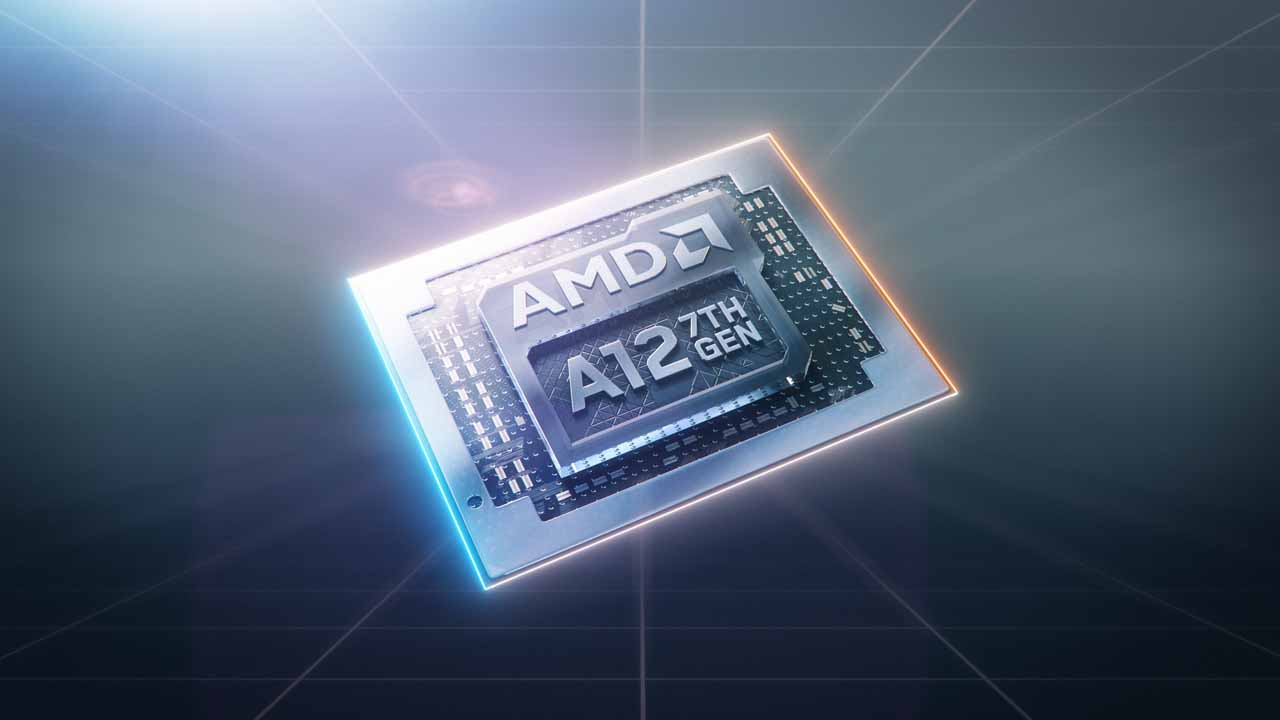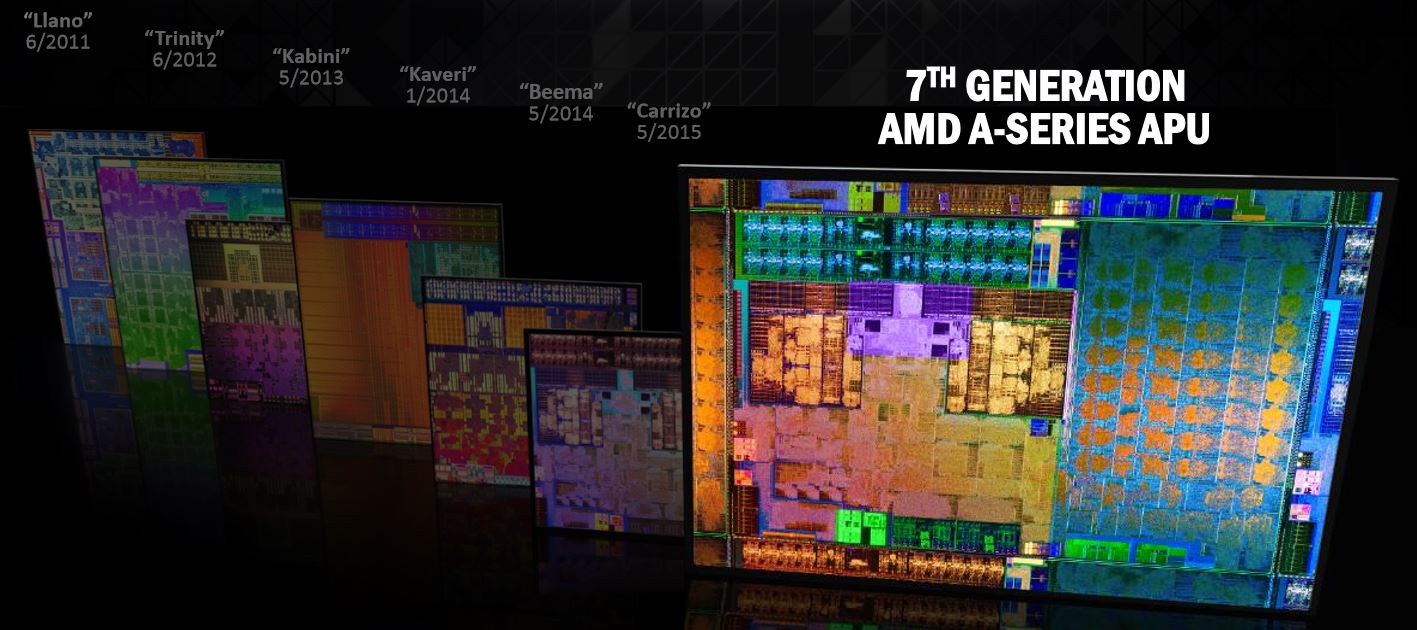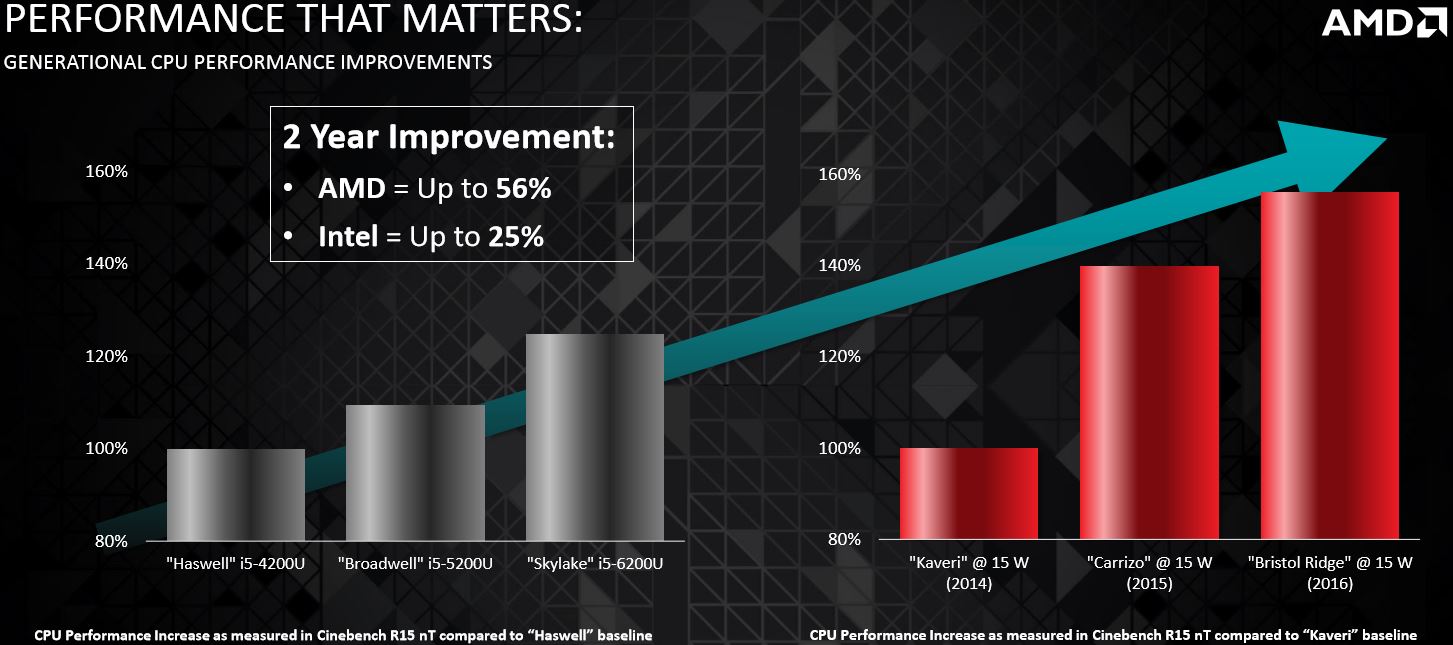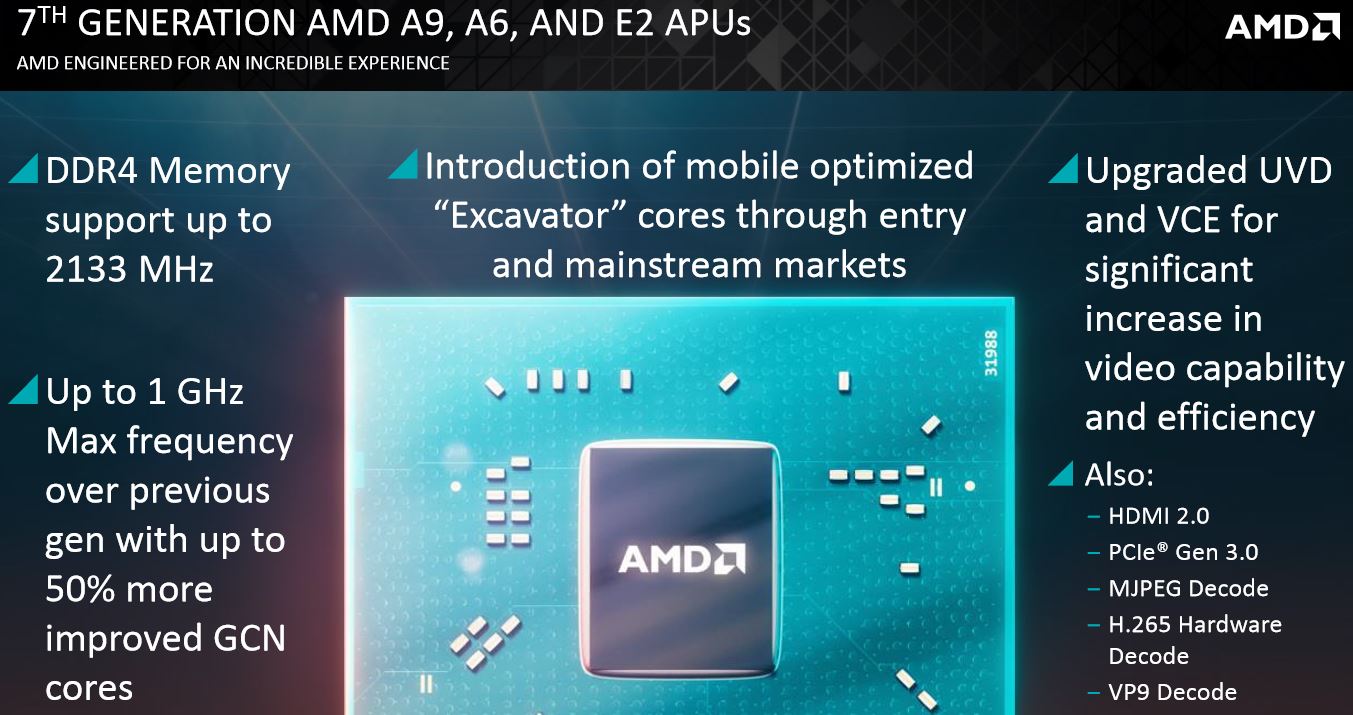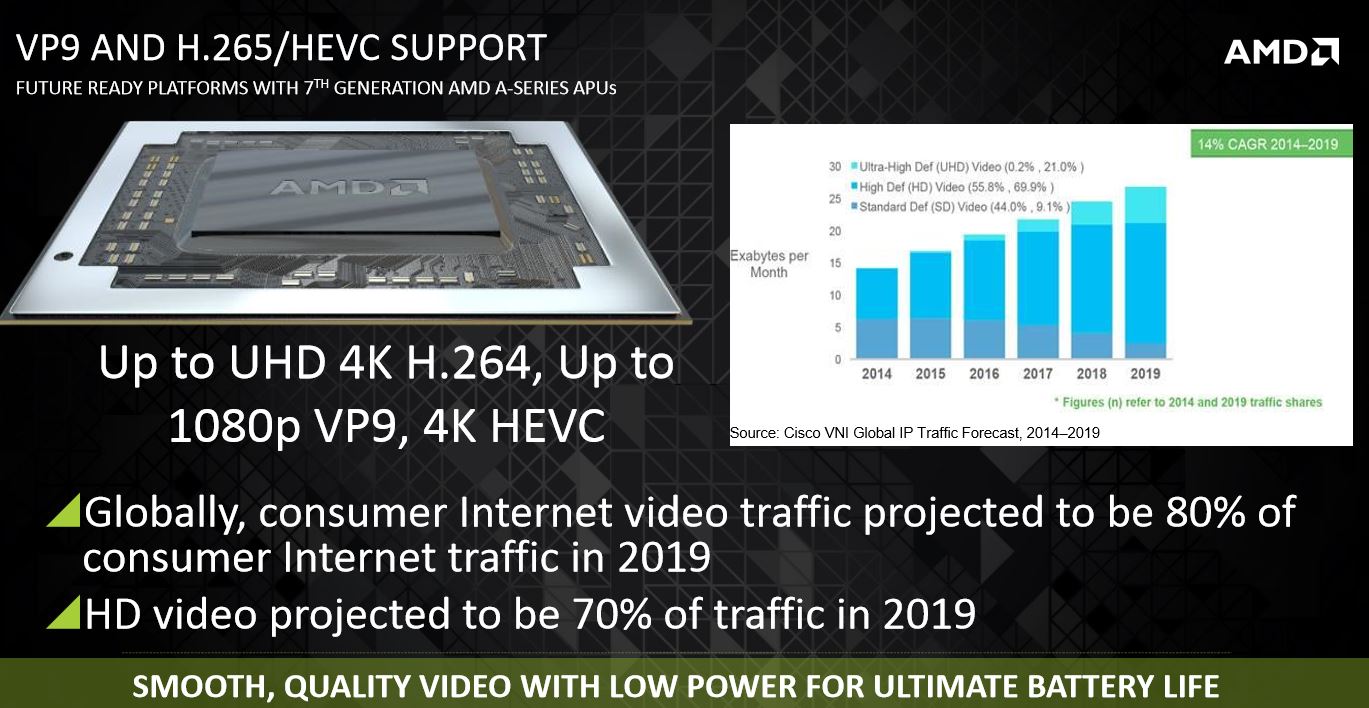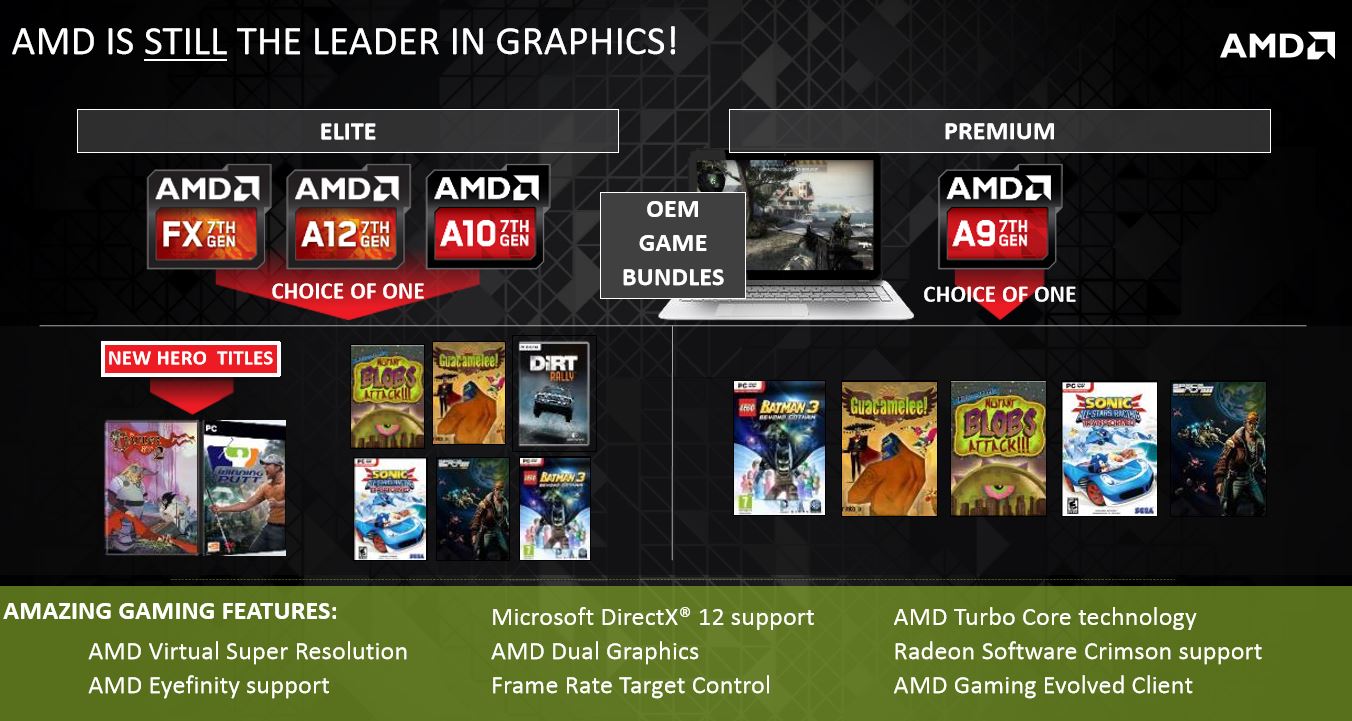AMD Details Bristol Ridge And Stony Ridge A-Series APUs At Computex 2016
AMD announced its Bristol Ridge and Stony Ridge 7th-Generation A-Series processors at Computex 2016. The company touts these as offering more performance with lower power consumption in a wide variety of mobile applications. But despite the naming and generation increment, these are a continuation of, and improvement upon Carrizo and Excavator.
AMD 7th-Generation A-Series APU
AMD separated the A-Series APUs into Bristol Ridge and Stony Ridge categories, which service the high end and mainstream/value market segments, respectively. AMD focused on improving performance for both standard compute and graphics processing, and also strived to reduce power consumption significantly to meet its "25x20" initiative (which seeks to improve energy efficiency 25x by the year 2020). AMD claims to be well underway to meeting its goals, and cites a 41 percent reduction in energy consumption during video playback in comparison to its previous-generation A-Series APUs.
AMD also provided a comparison chart to illustrate that it is providing a more rapid pace of generation-over-generation CPU performance improvements than Intel, but we caution readers that all of the test results in this article reflect AMD's own internal testing. AMD was candid and admitted that it needed to improve its performance rapidly to catch up with, and eventually overtake, Intel.
AMD claimed that it increased performance with 15W processors by 56 percent over the previous two years (which spans three generations of AMD and Intel products) in comparison to Intel's 25 percent increase. AMD conducted the test with Cinebench R15 and employed the Kaveri and Haswell i5-4200U processors as the baseline, but it is worth noting that the use of one benchmark is hardly enough to provide a broad indication of overall CPU performance.
Bristol Ridge
| 7th-Generation Bristol Ridge A-Series | FX 9830P | FX 9800P | A12-9730P | A12-9700P | A10-9630P | A10-9600P |
|---|---|---|---|---|---|---|
| Radeon Graphics | R7 Graphics | R7 Graphics | R7 Graphics | R7 Graphics | R5 Graphics | R5 Graphics |
| CPU Cores | 4 | 4 | 4 | 4 | 4 | 4 |
| Max/Base CPU Frequency (GHz) | 3.7 / 3.0 | 3.6 / 2.7 | 3.5 / 2.8 | 3.4 / 2.5 | 3.3 / 2.6 | 3.3 / 2.4 |
| Graphics Cores | 8 | 8 | 6 | 6 | 6 | 6 |
| Process | 28nm | 28nm | 28nm | 28nm | 28nm | 28nm |
| DDR4 Dual Channel Memory Support | 2400 MHz | 2400 MHz | 2400 MHz | 2400 MHz | 2400 MHz | 2400 MHz |
| TDP | 35W | 15W | 35W | 15W | 35W | 15W |
| Configurable TDP Range | 25-45 | 12-15 | 25-45 | 12-15 | 25-45 | 12-15 |
AMD based the Bristol Ridge product stack upon the same architecture as the sixth-generation Carrizo APU, which means that it employs the same 28nm process, Excavator CPU and GCN (Graphics Core Next) cores. AMD optimized the 28nm process to speed up the transistors, thus boosting performance and reducing power consumption. The Bristol Ridge products also feature a dual-channel memory configuration, whereas the Stony Ridge variants are single channel, but both add support for up to DDR4 2400 MHz RAM (in comparison to the DDR3 2133 MHz RAM supported with Carrizo).
AMD APUs provide a configurable TDP range so that OEMs can tailor the device to fit within specific thermal and power consumption envelopes. Unfortunately, the Carrizo series featured a wide TDP range, which made it hard for users to ascertain the actual performance of the underlying APU (vendors are not required to disclose the setting). AMD responded to customer feedback and tightened the allowable TDP adjustment range to avoid the problem in the future.
Carrizo employed 10 Automated Voltage Frequency Scaling (AVFS) modules per Excavator core to improve energy efficiency, and the company optimized the Bristol Ridge implementation to extract more efficiency from the processor. The company also included software optimizations for Windows 10, video playback and offloading, along with driver improvements.
Get Tom's Hardware's best news and in-depth reviews, straight to your inbox.
The optimizations to the actual architecture are limited, but AMD claims to offer impressive performance improvements, such as 53 percent more graphics performance than Core i7 with the top-binned Bristol Ridge SKU (though the company did not quantify how it derived the measurement). AMD also touted that the proven and stable architecture eases the OEM qualification process.
The AMD deck included a specific performance breakout of the new Bristol Ridge A12 flagship model in comparison to the previous-generation Carrizo A10-8700P. AMD's test results indicate an appreciable increase in both 3DMark 11 and Cinebench R15 test results.
Stony Ridge
| 6th-Generation Carrizo A-Series | A9-9410 | A6-9210 | E2-9010 |
|---|---|---|---|
| Radeon Graphics | R5 Graphics | R4 Graphics | R2 Graphics |
| CPU Cores | 2 | 2 | 2 |
| Max/Base CPU Frequency (GHz) | 3.5 / 2.9 | 2.8 / 2.4 | 2.2 / 2.0 |
| Graphics Cores | 3 | 3 | 2 |
| Process | 28nm | 28nm | 28nm |
| DDR4 Single Channel Memory Support | 2400 MHz | 2400 MHz | 2400 MHz |
| TDP | 15W | 15W | 15W |
| Configurable TDP Range | 10-25 | 10-15 | 10-15 |
The Stony Ridge products address the value segment of the market and displace the Carrizo-L offerings. Stony Ridge received the biggest upgrades in terms of actual silicon enhancements. AMD swapped the CPU from the Jaguar core to the more-powerful Excavator core. This reduced the core count from four to two, but the new design provides more performance than the previous generation. AMD claims the improvements bring the Stony Ridge products into competitive range of the Intel i3 and i5 products.
The removal of two cores created enough spare real estate on the die to allow AMD to add a fifth GPU core to the Stony Ridge products. The company also expanded its support for a wide range of video codecs (and 4K video support) for the entire value stack, as well as improving its Unified Video Decoder (UVD) and Video Coding Engine (VCE).
The upgrades are important to further AMD's long running objective to provide the latest codecs and increase power efficiency during video playback, as industry trends illuminate a sharp rise in video traffic (especially with more demanding HD and 4K video streams).
AMD shared performance data comparing the Carrizo A9 to the A8-7410, which highlights an impressive 52 percent jump in CPU processing with Cinebench R15, and a 36 percent increase in 3D Mark 11.
Bundled Games And HP Envy x360
AMD aligns its graphics branding across its entire product stack, which means that an APU-powered system with a Radeon R5 graphics rating will provide similar performance to a discreet Radeon R5 graphics card. AMD offers game bundles with participating partners, and targets the free games to the capabilities of the underlying APU.
AMD On The Move
AMD has its work cut out, having slowly bled market share over the years, leaving Intel with a dominant position in the PC market. Simultaneously, both companies are suffering from the rapidly receding desktop PC market, which experienced a sharp 10.6 percent decline in 2015 (contributing to the lowest PC sales since 2007). AMD has precious little room for mistakes.
The company pointed out during press briefings that it is focused on the PC market, and it also took a casual swipe at Intel and Nvidia by stating that it is not pulling back from the PC market and is not distracted by other pursuits, such as drones or automobiles, alluding to Intel's ongoing restructuring initiative and Nvidia's automobile efforts. But it is notable that AMD is also working to diversify its business as a reaction to the declining PC market.
There are several bright signs on the horizon for AMD, including the lucrative APU business that is propelled (in part) by design wins in the PlayStation 4 and Xbox One. The company also recently licensed its x86 processor technology to a China-based joint venture with Tainjin Haiguang Advanced Technology Investment Co (THATIC), which will manufacture processors specifically for the China market. After AMD announced the deal in mid-April it spurred a sharp rise in AMD's stock price, which is currently trading at its highest level since 2012, and still climbing.
AMD's forthcoming Zen CPU, which the company claims provides a 40 percent IPC improvement over its previous generation CPU, also appears to be promising.
But Carrizo saw its fits and starts with OEMs and end customer wins, so Bristol Ridge and Stony Ridge will be important tests of AMD's resilience in the mobile arena. The company wants to deliver a big performance increase in this growing value segment, but OEM design wins will be the deciding factor for Bristol Ridge and Stony Ridge A-Series APUs.
Paul Alcorn is a Contributing Editor for Tom's Hardware, covering Storage. Follow him on Twitter and Google+.

Paul Alcorn is the Editor-in-Chief for Tom's Hardware US. He also writes news and reviews on CPUs, storage, and enterprise hardware.
-
Martell1977 I think the decline in the desktop market is mostly due to need. I look at my desktop that I built in Dec. 2010 and the only thing I have needed to upgrade was the GPU (6870 to R9 390). The CPU runs everything I throw at it and does so in stride. Intel is on the 6th generation Core CPU's and I haven't found a need to replace my 1st generation i7-950, plus, I haven't even overclocked it yet. It doesn't help that the last big increase in CPU performance was from gen 1 to gen 2.Reply
Supply and demand, but with the CPU market as it is, there isn't much need driving demand like there was before the Core series. Maybe when software demands more power from the CPU, things will change. The GPU market seems fairly healthy right now as the software increases the demand.
There seems to be a lull in the CPU market that is driven by a lull in CPU performance increases. -
apazeus In my humble opinion, part of the reason the PC industry seems to be plateauing in terms of growth is because, over the past few years, hardware has become good enough that it can all handle the average user's needs without needing to be replaced for a long time. It's interesting to see a company like AMD focus so heavily on all-in-one chips. This segment has a legitimate shot to become THE segment within the no too distant future.Reply -
alextheblue Replacing the aging Jaguar quad cores in the entry-level segment with a pair of Excavator cores was a great move. Overall performance might be up, but the biggest gain is single threaded performance! That should make cheaper machines feel more responsive in daily tasks.Reply
For Bristol Ridge, I'm glad they segregated more by TDP. That helps tighten the range and allows consumers to genuinely configure a custom machine with the TDP they want (or closer to it). We'll have to see if any OEMs release a single-channel-only solution this time around for Bristol Ridge - the TDP issue is under control, so I hope we don't see a repeat of the memory debacle too. -
none12345 So, i dont get it.Reply
Nvidia announces 1080, and no mention of paper launch(which was correct at the time). They said cards will be avaliable on xxxx date, cards were available on xxx but sold out in minutes because there was extremely short supply. Thats a paper launch, and i didnt see mention of the term until it actually happened on this site. Which is the way it should have been.
AMD says something about polaris, and does NOT say a date that it will be released, and its immediately branded a paper launch? WTF.
Its only a paper launch if they promise it on a certain date, and dont deliever, or deliver very few units for weeks or months. -
bit_user FFS, another round of 28 nm! Enough!Reply
AMD could kill Intel on the VR-ready PC front, if they'd pack a Zen core with their Radeon 480 and 16 GB of HBM2 into a single APU. It'd be an expensive product, but would probably enable sub-$800 VR-ready PCs, with well above the minimum specs.
But I've no doubt Intel will beat them to the punch.
-
InvalidError Reply
4GB of HBM2 on an APU would be more than enough when there is 16GB of much cheaper DDR4-2400 next to it. The IGP only needs enough HBM to cache actively used data and from Intel's Broadwell, we know that even a meager 128MB of local buffer already goes a long way towards covering that.18050682 said:AMD could kill Intel on the VR-ready PC front, if they'd pack a Zen core with their Radeon 480 and 16 GB of HBM2 into a single APU. -
eklipz330 ReplyFFS, another round of 28 nm! Enough!
if they did that and it was priced cheaper than those parts if purchased individually, home theater market would explode. I would be willing to put down $500 on a chip like that, and all i would need is a case, mobo, psu and ssd... that form factor would be sleek
AMD could kill Intel on the VR-ready PC front, if they'd pack a Zen core with their Radeon 480 and 16 GB of HBM2 into a single APU. It'd be an expensive product, but would probably enable sub-$800 VR-ready PCs, with well above the minimum specs.
But I've no doubt Intel will beat them to the punch. -
mavikt They don't make it easy for themselves, 25 times improved energy efficiency, on 28nm... Wonder if that was intentional or are they planing on a die-shrink before 2020?Reply -
somebodyspecial ROFL. 28nm in mid 2016. FAIL. If you own AMD stock you may want to sell before the next quarterly report ;) I don't expect them to make money unless ZEN is larger than 200mm^2 and really, I mean won't make much unless it's >250mm^2 (Note AMD has done 300mm^2 before). AMD keeps aiming for low-end garbage that has no pricing power. A HUGE ZEN core could be priced above Intel chips at every level. If ZEN is not at least 50% larger (cpu die to cpu die) vs. Intel's current gen cpu, they won't be able to price for profit. If it is anywhere near equal, even if it wins in this or that (while losing some crap to intel in other stuff) Intel will just price it to death until they win everything again.Reply
Dirk M. was correct. You NEED a KING CPU before bothering with anything else. Same story for GPU, ask NV how those profits are on their top 3-5 cards (pro included).
Console margins will never make AMD rich either, which is why NV passed. You need to spend R&D where you get the best bang for your buck (highest margins!). Then once richer (or in AMD's case actually making profit for a year solid), you can try crap like a console, apu, etc that make peanuts. Quarter after quarter AMD set sales records for cpu shipments (with apu), yet made loss after loss. Quit making crap that can't price like god's gift to mankind or get it over with and go bankrupt. 28nm...pfft.
